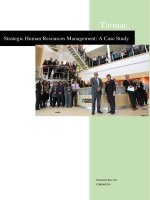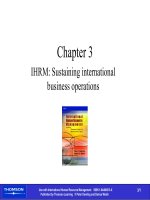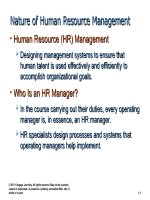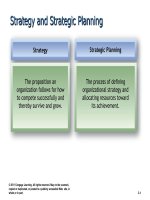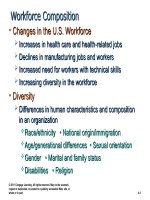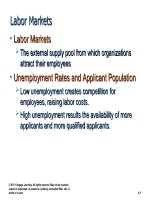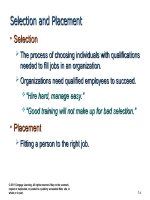HRM 5th chapter 15 international human resources management
Bạn đang xem bản rút gọn của tài liệu. Xem và tải ngay bản đầy đủ của tài liệu tại đây (544.5 KB, 41 trang )
International Human
Resources Management
Managing Human Resources
Belcourt * Bohlander * Snell
Copyright © 2008 by Nelson, a division of Thomson
Canada Limited.
All rights reserved.
5th Canadian edition
PowerPoint Presentation by
Monica Belcourt, York University and
Charlie Cook, The University of West Alabama
Objectives
After studying this chapter, you should be able to:
1. Identify the types of organizational forms used for
competing internationally.
2. Explain the economic, political-legal, and cultural
factors in different countries that HR managers
need to consider.
3. Explain how domestic and international HRM differ.
4. Discuss the staffing process for individuals working
internationally.
5. Identify the unique training needs for international
Copyright
© 2008and
by Nelson,
a
assignees
their employees.
division of Thomson Canada
Ltd.
15–2
Objectives
(cont’d)
After studying this chapter, you should be able to:
6. Identify the characteristics of a good international
compensation plan.
7. Reconcile the difficulties of home- and host-country
performance appraisals.
8. Explain how labour relations differ around the
world.
Copyright © 2008 by Nelson, a
division of Thomson Canada
Ltd.
15–3
Increasing Importance of Global Human Resource
Understanding
International
International
Mergers
Mergersand
and
Acquisitions
Acquisitions
Foreign
ForeignHuman
Human
Resources
Resources
Importance
Importanceof
of
Global
GlobalHuman
Human
Resources
Resources
Management
Management
Global
Global
Competition
Competition
Market
MarketAccess
Access
Nelson,
a
Opportunities
Opportunities
Copyright © 2008 by
division of Thomson Canada
Ltd.
15–4
Managing Across Borders
• International corporation
• Global corporation
Domestic firm that uses its
existing capabilities to
move into overseas
markets.
Firm that has integrated
worldwide operations
through a centralized home
office.
• Multinational corporation
(MNC)
• Transnational corporation
Firm with independent
business units operating in
multiple countries.
Copyright © 2008 by Nelson, a
division of Thomson Canada
Ltd.
Firm that attempts to
balance local
responsiveness and global
scale via a network of
specialized operating units.
15–5
Types of Organizations
Copyright © 2008 by Nelson, a
division of Thomson Canada
Ltd.
Figure 15.1
15–6
Top International Companies
MARKET VALUE
(BILLIONS OF U.S. DOLLARS)
1. General Electric
$286.10
2. Microsoft
263.99
3. ExxonMobil
244.93
4. Pfizer
244.89
5. Wal-Mart Stores
232.22
6. Citigroup
210.86
7. Johnson & Johnson
161.36
8. Royal Dutch/Shell Group
158.48
Copyright 9.
©BP
2008 by Nelson, a
division of10.
Thomson
Canada
AIG
Ltd.
Source: Chester Dawson, “The Global 1000,” Business Week, July 14, 2003, 34.
153.24
150.97
15–7
Figure 15.2
Top International Companies (cont’d)
SALES
(BILLIONS OF U.S. DOLLARS)
1. Wal-Mart Stores
$244.52
2. ExxonMobil
204.51
3. General Motors
184.21
4. Royal Dutch/Shell
179.43
5. BP
178.72
6. Ford Motor
162.59
7. DaimlerChrysler
156.84
8. Toyota Motor
134.23
9. General Electric
131.70
Copyright 10.
© 2008
by Nelson, a
Allianz
division of Thomson Canada
Ltd.
Source: Chester Dawson, “The Global 1000,” Business Week, July 14, 2003, 34.
126.80
15–8
Figure 15.2
Top International Companies (cont’d)
PROFITS
(BILLIONS OF U.S. DOLLARS)
1. Citigroup
$15.32
2. General Electric
15.13
3. Altria Group
11.10
4. ExxonMobil
11.01
5. Royal Dutch/Shell
9.42
6. Bank of America
9.25
7. Pfizer
9.18
8. Wal-Mart Stores
8.04
9. Toyota Motor
7.90
Copyright 10.
© 2008
by Nelson, a
Microsoft
division of Thomson Canada
Ltd.
Source: Chester Dawson, “The Global 1000,” Business Week, July 14, 2003, 34.
7.83
15–9
Figure 15.2
How International Companies Affect the
World Economy
• Their production and distribution extend beyond
national boundaries, making it easier to transfer
technology.
• They have direct investments in many countries,
affecting the balance of payments.
• They have a political impact that leads to
cooperation among countries and to the
breaking down of barriers of nationalism.
Copyright © 2008 by Nelson, a
division of Thomson Canada
Ltd.
15–10
How Does the Global Environment
Influence Management?
• Unified Economies
Closely partnered nations such as the European
Union (EU) have developed into strong competitors.
Promotes job growth in trading nations.
• Cultural environment
The communication patterns, religion, values and
ideologies, education, and social structure of a host
country influence how HR is conducted in that
country.
Copyright © 2008 by Nelson, a
division of Thomson Canada
Ltd.
15–11
The
TheNations
Nationsof
ofthe
the
European
EuropeanUnion
Union
Copyright © 2008 by Nelson, a
division of Thomson Canada
Ltd.
15–12
Cultural Environment of International Business
Copyright © 2008 by Nelson, a
division of Thomson Canada
Ltd.
Figure 15.3
15–13
Domestic versus International HRM
• Issues in international HRM in helping
employees adapt to a new and different
environment outside their own country:
Relocation
Orientation
Objective
Translation services
Copyright © 2008 by Nelson, a
division of Thomson Canada
Ltd.
15–14
International Staffing
• Expatriates, or Home-country Nationals
Employees from the home country who are on
international assignment.
• Host-country Nationals
Employees who are natives of the host country.
• Third-country Nationals
Employees who are natives of a country other than
the home country or the host country.
Copyright © 2008 by Nelson, a
division of Thomson Canada
Ltd.
15–15
Changes in International Staffing over Time
Copyright © 2008 by Nelson, a
division of Thomson Canada
Ltd.
Figure 15.4
15–16
Hiring Host-Country Nationals
• Three main advantages:
1. Hiring local citizens is generally less costly than
relocating expatriates.
2. Since local governments usually want good jobs for
their citizens, foreign employers may be required to
hire locally.
3. Most customers want to do business with
companies they perceive to be local versus foreign.
Copyright © 2008 by Nelson, a
division of Thomson Canada
Ltd.
15–17
Recruiting Internationally
• Work Permit, or Visa
Government document granting a foreign individual
the right to seek employment.
• Guest Workers
Foreign workers invited to perform needed labour.
• Apprenticeships
Vocational training programs in skilled trades.
• Transnational Teams
Teams composed of members of multiple
nationalities working on projects that span multiple
Copyright © 2008 by Nelson, a
countries.
division of Thomson Canada
Ltd.
15–18
Selecting Global Managers
• Global manager
A manager equipped to run an international business
• Skills Categories
Ability to seize strategic opportunities
Ability to manage highly decentralized organizations
Awareness of global issues
Sensitivity to issues of diversity
Competence in interpersonal relations
Skill in building community
Copyright © 2008 by Nelson, a
division of Thomson Canada
Ltd.
15–19
Selecting Global Managers
1.
2.
3.
4.
Begin with self-selection.
Create a candidate pool.
Assess core skills.
Assess augmented skills and attributes.
Copyright © 2008 by Nelson, a
division of Thomson Canada
Ltd.
15–20
Highlights in HRM
Skills of Expatriate Managers
CORE SKILLS
Experience
Decision making
Resourcefulness
Adaptability
Cultural sensitivity
Team building
Maturity
Copyright © 2008 by Nelson, a
division of Thomson Canada
Ltd.
AUGMENTED SKILLS
Technical skills
Negotiation skills
Strategic thinking
Delegation skills
Change management
Highlights 15.4
15–21
Measured Expatriate Characteristics
• Core Skills
Skills that are considered
critical to an employee’s
success abroad.
• Augmented Skills
Skills that are helpful in
facilitating the efforts of
expatriate managers.
• Failure rate
Percentage of expatriates who
do not
perform
satisfactorily.
Copyright
© 2008
by Nelson,
a
division of Thomson Canada
Ltd.
15–22
Comparison of Advantages in Sources of Overseas Managers
HOST-COUNTRY
NATIONALS
HOME-COUNTRY NATIONALS
(EXPATRIATES)
THIRD-COUNTRY
NATIONALS
Less costly
Talent available within company
Broad experience
Preferred by host-country
outlook governments
Greater control
International
Intimate knowledge of
environment and culture
Company experience
Multilingualism
Language facility
Mobility
Experience provided to corporate
executives
Copyright © 2008 by Nelson, a
division of Thomson Canada
Ltd.
Figure 15.6
15–23
Expatriate Selection Criteria
Copyright © 2008 by Nelson, a
division of Thomson Canada
Ltd.
Figure 15.7
15–24
Causes of Expatriate Assignment Failure
• Family adjustment
• Lifestyle issues
• Work adjustment
• Bad selection
• Poor performance
• Other opportunities arise
• Business reasons
• Repatriation issues
Copyright © 2008 by Nelson, a
division of Thomson Canada
Ltd.
Figure 15.8
15–25

